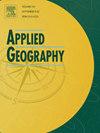Achieving win–win outcomes between urban growth and urban greening: The role of environmental governance
IF 5.4
2区 地球科学
Q1 GEOGRAPHY
引用次数: 0
Abstract
Rapid urbanization challenges environmental sustainability, yet synergistic pathways remain underexplored in developing economies. This study investigates the impact of urban growth on urban greenness and the moderating role of environmental governance, using empirical data from 273 cities in China (2001–2019) and a two-way fixed effects model. Key findings are as follows: (1) An N-shaped relationship exists between urban economic growth and urban greenness, with inflection points at approximately 3500 CNY and 130,000 CNY in per capita GDP. Most cities in 2019 had surpassed the first inflection point but remained in the declining phase. Population density significantly increases greenness (β = 0.0139∗, p < 0.1), while land expansion has no statistically significant impact. (2) Environmental governance positively moderates growth–greening relationships. Economic growth enhances greenness when governance intensity (EGOV) exceeds 1.8 (marginal effect: +0.0204, p < 0.01) and land expansion improves greenness at EGOV >0.5 (interaction effect: +0.0003, p < 0.1). (3) Spatial heterogeneity analyses confirm stronger governance effects in western/northeastern regions and large cities. These results indicate that effective environmental governance can mitigate adverse effects of economic expansion, fostering a “win-win” between urban development and greening. Policymakers should prioritize governance capacity building, stage-adaptive interventions, and inter-city collaboration to balance development and sustainability.
实现城市发展与城市绿化的共赢:环境治理的作用
快速城市化对环境的可持续性提出了挑战,但发展中经济体的协同途径仍未得到充分探索。本研究利用2001-2019年中国273个城市的实证数据和双向固定效应模型,探讨了城市增长对城市绿化的影响以及环境治理的调节作用。研究发现:(1)城市经济增长与城市绿化度呈n型关系,在人均GDP分别为3500元和13万元左右出现拐点。2019年,大多数城市已经超过了第一个拐点,但仍处于下降阶段。人口密度显著增加绿化度(β = 0.0139∗,p <;0.1),而土地扩张没有显著影响。(2)环境治理正向调节增长-绿化关系。当治理强度(EGOV)超过1.8时,经济增长增强绿色度(边际效应:+0.0204,p <;0.01),在EGOV >;0.5(交互效应:+0.0003,p <;0.1)。(3)空间异质性分析表明,西部/东北地区和大城市的治理效果更强。这些结果表明,有效的环境治理可以缓解经济扩张的不利影响,促进城市发展与绿化的“双赢”。决策者应优先考虑治理能力建设、阶段适应性干预和城市间合作,以平衡发展和可持续性。
本文章由计算机程序翻译,如有差异,请以英文原文为准。
求助全文
约1分钟内获得全文
求助全文
来源期刊

Applied Geography
GEOGRAPHY-
CiteScore
8.00
自引率
2.00%
发文量
134
期刊介绍:
Applied Geography is a journal devoted to the publication of research which utilizes geographic approaches (human, physical, nature-society and GIScience) to resolve human problems that have a spatial dimension. These problems may be related to the assessment, management and allocation of the world physical and/or human resources. The underlying rationale of the journal is that only through a clear understanding of the relevant societal, physical, and coupled natural-humans systems can we resolve such problems. Papers are invited on any theme involving the application of geographical theory and methodology in the resolution of human problems.
 求助内容:
求助内容: 应助结果提醒方式:
应助结果提醒方式:


